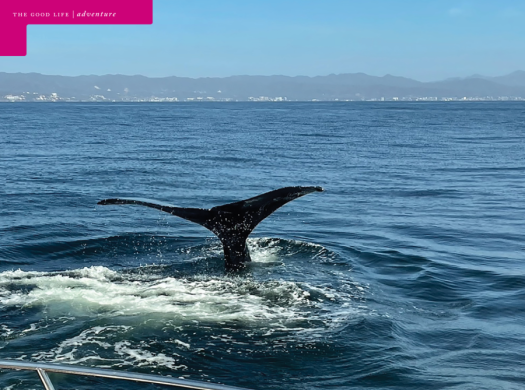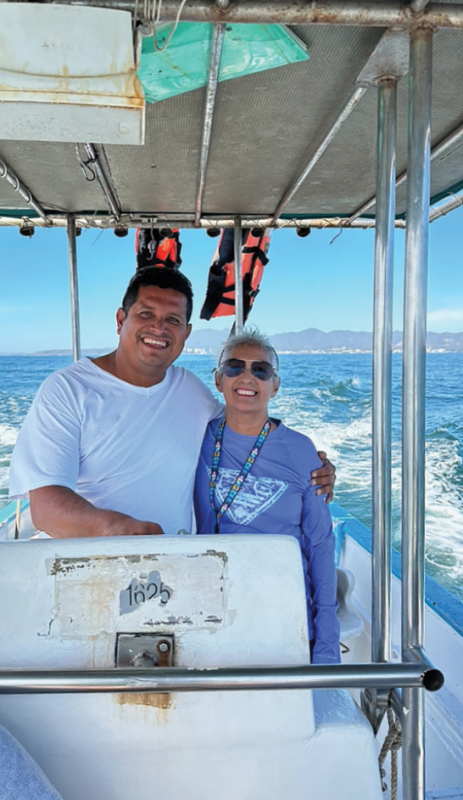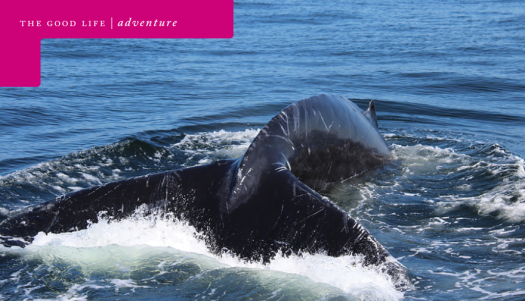

 Spring '24 Issue - Best Of Winners Announced & More
Spring '24 Issue - Best Of Winners Announced & More 
Thursday, April 4, 2024
The Whale Lady
The Whale Lady
Spring Training With Humpback Whales
Photography: Taylor Rose Stone
Writer: Lee Juillerat
Some people head to Arizona or Florida for “spring training” baseball games. Not Taylor-Rose Stone. For the past five years she’s spent her spring months in Puerto Vallarta, Mexico, working as an interpreter on whale watching excursions. “Spring training” involves watching mother humpbacks and their escorts train fast-growing newborn calves for the seasonal migration north.
“I’m pretty much OCD when it comes to whales,” chirps Stone, 64, whose unbridled enthusiasm makes her a favorite on guided whale watching outings. “I have a lot of repeat customers.”
Whale watching on the balmy South Pacific Ocean is quite a lifestyle shift. When not at Puerto Vallarta, Stone, who was raised in Klamath Falls, lives in the Crescent Lake area. Over the past several years she’s become highly knowledgeable about humpbacks, which she regards as her totem animal because, “I feel them, and I know they feel me.”
Stone earned the nickname Whale Lady because whenever she’s near the beach or on a boat, humpbacks appear. Others have told her, “You are their voice.” As their voice, she revels in telling humpback stories and advocating for their protection. As she explains, “I want to give something back to whales because they gave me back my life.”
Learning about and leading whale watching outings weren’t part of her life plan. In 2018, a time when life had dealt Stone a series of setbacks, she decided to treat herself to her “No. 1 bucket list item, an Alaskan cruise.” While cruising in the Icy Strait Point she saw a humpback whale.
“Something happened to me at that moment,” she remembers. “I found something to be passionate about.”
After returning to Crescent Lake, she decided to temporarily relocate to Maui, where the National Oceanic and Atmospheric Administration (NOAA) operates the Hawaiian Islands Humpback Whale Marine Sanctuary. She completed a 20-hour training course and volunteered at events sponsored by NOAA and other whale organizations. Stone studied humpbacks from shore, on her own, and participated in whale counts and NOAA-supported studies about whale harassment by boaters.
In 2021, she went to Puerto Vallarta, where humpbacks seasonally migrate to give birth, to learn more and serve as an interpreter on tour boats with certified captains. Stone’s ongoing information gathering allows her to reel off a Wikipedia’s worth of humpback-related data. Samples: humpbacks, a species of baleen whales, weigh 45 tons and are 45-feet-long; whales have been on Earth for 63 million years; they are called ballena in Mexico and koholā in Hawaii; mothers nurse their young for a year then leave; baby humpbacks nurse 32,000 gallons of milk from their mothers in their first year—they have to get fat on to make that four-to-six week migration; the term for a sleeping whale is “logging;” and, no, a humpback cannot swallow a person.
She ticks off the information matter-of-factly and professorially. “I really immersed myself because I’m so passionate about them. It’s just amazing to me how they can control all that mass. It’s so much fun to watch the babies.”
Stone’s face lights up and her voice erupts in high-pitched cheerier tones when telling about and playing recordings of the haunting “songs” of humpbacks, which are regarded as the most vocal of all whale species. Humpbacks, so named because of their distinctive humps on their backs, are a favorite with whale watchers because they often jump out of the water, slapping the surface with their fins.
Whale-watching season in Puerto Vallarta typically begins in November and continues through spring, when humpbacks and gray whales begin their trek to the more productive feeding grounds of Alaska, British Columbia, and the Arctic Ocean. In typical years they pass along ocean waters in far Northern California and Southern Oregon in April and May. For humpback calves, “spring training” involves mothers and escorts training calves how to feed on shrimp-like crustaceans like krill and small fish by straining huge volumes of ocean water through their sieve-like baleen plates.
Along with informing others during tour, Stone’s giving back includes a self-published book, Whales in the Air: A Look at Humpback Whale Courtship, that tells the story of a January 2022 encounter with a female humpback, Ava, during a tour in Banderas, Jalisco, Mexico. That day Ava repeatedly rolled on her back and slapped the water with her pectoral fins, a signal that she was receptive to mating. Stone weaves humpback facts into her tale, including how whales can be identified by unique markings on their flukes, which are also called tails. She believes Ava sensed something about her, a belief strengthened when the massive humpback suddenly and unexpectedly appeared under Stone’s feet, which were dangling over the bow of the boat.
“This was the whale that could have taken me out,” she wrote. “She didn’t. I have never known such a moment of pure heart joy as she flew in the air right in front of me. I felt Ava had just blessed me and all the passengers on that boat. It was a moment I will never forget.”
What moments are ahead for Stone when she returns to Puerto Vallarta? “When I see one I’ll be screaming at the top of my lungs,” she says with a raucous belly-laugh then, after a deep breath, “It’s a world I never guessed I’d be in. I dream about whales.”
thewhalelady1@gmail.com
Events & Promotions
Apr
29
May
03
Gold Hill
Del Rio Vineyard Dinner in the Vineyard Spring edition OREGON FEAST
Let's celebrate Oregon Wine Month. Join us for an evening of wine ...
Jun
16
Grants Pass | Ends Jul 04, 2024
Racing on the Rogue is back in 2024 at Oregon’s premier racetrack, Grants Pass Downs!
Racing on the Rogue is back in 2024 at Oregon’s premier racetrack, ...
Jun
29
Gold Hill
Del Rio Vineyards Dinner Under the Stars
Let us dazzle you with an evening under the stars in our picturesque ...
Sep
21
2310 Voorhies Rd
Oregon Honey and Mead Festival
Oregon Honey and Mead Festival Honey, Music, Art, Native ...















